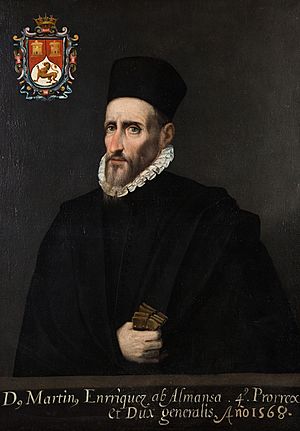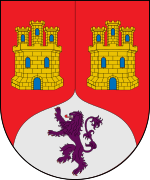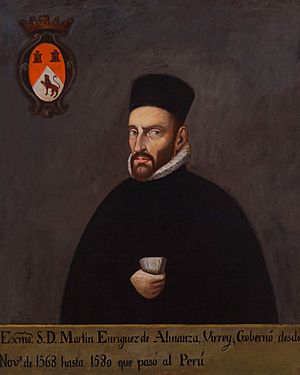Martín Enríquez de Almanza facts for kids
Quick facts for kids
The Most Excellent
Martín Enríquez de Almanza
|
|
|---|---|
 |
|
| 4th Viceroy of New Spain | |
| In office November 5, 1568 – October 3, 1580 |
|
| Monarch | Philip II |
| Preceded by | Gastón de Peralta, 3rd Marquess of Falces |
| Succeeded by | Lorenzo Suárez de Mendoza, 4th Count of La Coruña |
| 6th Viceroy of Peru | |
| In office September 23, 1581 – March 13, 1583 |
|
| Monarch | Charles I of Spain |
| Preceded by | Francisco de Toledo |
| Succeeded by | Fernando Torres de Portugal y Mesía |
| Personal details | |
| Born |
Martín Enríquez de Almanza y Ulloa
Toro, Zamora Spain |
| Died | March 13, 1583 Lima, Viceroyalty of Peru |
| Signature |  |
Martín Enríquez de Almanza y Ulloa (died around March 13, 1583) was an important leader in the Spanish colonies. He served as the fourth viceroy of New Spain (which is now Mexico). He ruled from November 5, 1568, to October 3, 1580, on behalf of King Philip II.
Like many early viceroys, Martín Enríquez de Almanza came from a noble family. He was part of the House of Enríquez, a branch of the royal family that ruled Castile. Even though he was from a royal family, he never inherited a specific title himself.
He was 60 years old when he became viceroy of New Spain. He brought strength and order after a time of trouble. Some powerful Spanish settlers, called encomenderos, including Hernán Cortés's son, Don Martín Cortés, had challenged the king's power. Enríquez de Almanza helped the king regain control. Later, he became the viceroy of Peru from September 23, 1581, until he died in 1583. He was 72 when he took this job, and he didn't really want it. In Mexico, he was a very good leader. He made sure the king's power was strong and built defenses against native groups who threatened the important silver mines in the north.
Contents
Early Life
Martín Enríquez de Almanza y Ulloa was born to Francisco Enríquez de Almanza, who was the first Marquess of Alcañices. His father was a great-great-grandson of Infante Fadrique Alfonso of Castile, who was a son of Alfonso XI of Castile. His mother, Isabel de Ulloa y Castilla, also had royal family connections on her mother's side.
His Time as Viceroy in New Spain
The Council of the Indies chose Enríquez de Almanza to be viceroy. When he first arrived in New Spain at Veracruz, his first job was to remove English pirates. These pirates were using Isla de Sacrificios as a base to attack the coast and Spanish ships. When he reached Mexico City, he quickly worked to fix the problems left by the previous leader of the Real Audiencia (a high court), Alonso Muñoz.
Enríquez de Almanza also helped settle disagreements between the bishops and the religious groups (like friars and nuns) in New Spain. This argument started when a royal rule said that local churches should be run by secular clergy (priests who work in the community), not by friars or nuns who live in convents. The religious orders didn't want to follow this rule. The Franciscans even threatened to leave Mexico City. The viceroy convinced them to return after making some agreements.
In 1570, the viceroy personally led a trip against the native tribes that were causing trouble in the area. However, he did not agree to a full war against the Chichimeca people. He built forts, called presidios, at Ojuelos and Portezuelos, along the road to Zacatecas. He also founded the town of San Felipe (Guanajuato) and many other towns, schools, and convents. In 1573, he started building the main Cathedral of Mexico City.
Helping the People
Enríquez de Almanza made sure that people who were sick or in need received medical care. He set up hospitals in the city to help victims of a terrible sickness, possibly chicken pox, which caused many deaths. He also created rules to protect native people from their Spanish employers. These rules made sure that native farmers and workers received fair pay.
The Inquisition Begins
During Enríquez de Almanza's time as viceroy, the Holy Office of the Inquisition was officially started in New Spain. It was also set up in Peru at the same time. Pedro Moya de Contreras, the first inquisitor in New Spain, arrived in 1571. The Inquisition was a religious court made up of important bishops. Its job was to watch over the religious practices of Spaniards and other non-native people in the area. It aimed to stop any secret Jewish communities (judaizantes) or Protestants. Native people were not under its control.
This religious court became very active. The first people judged by the Inquisition in the Americas were two Englishmen and an Irishman. They were found guilty of "Lutheran heresies" and were executed in Mexico City on April 15, 1574. About 200 people were judged in 1574, the year the first public ceremonies of judgment, called Autos de Fe, were held. The viceroy had to attend these ceremonies.
Viceroy of Peru
King Philip II of Spain heard many good things about Viceroy Enríquez de Almanza. The king knew about the clear improvements made during his rule. To show his appreciation, the king appointed him as the viceroy of Peru, which was a richer colony. Enríquez de Almanza sailed from the port of Acapulco on the Pacific Ocean in 1580.
He died in Lima, Peru, in 1583, while still serving as viceroy. After his death, the Audiencia (the high court) governed New Spain until the next viceroy, Lorenzo Suárez de Mendoza, 4th conde de la Coruña, arrived.
In Lima, people called him el Gotoso (The Goutish One) because he was often sick. He wasn't able to achieve much as viceroy of Peru and died three years into his term. Because of this, he is not remembered as one of the great viceroys of Peru. However, in New Spain, where he served for 12 years, he was seen as a "wise administrator." He is generally given credit for making the viceroy's job more respected and powerful.
See also
 In Spanish: Martín Enríquez de Almansa para niños
In Spanish: Martín Enríquez de Almansa para niños



